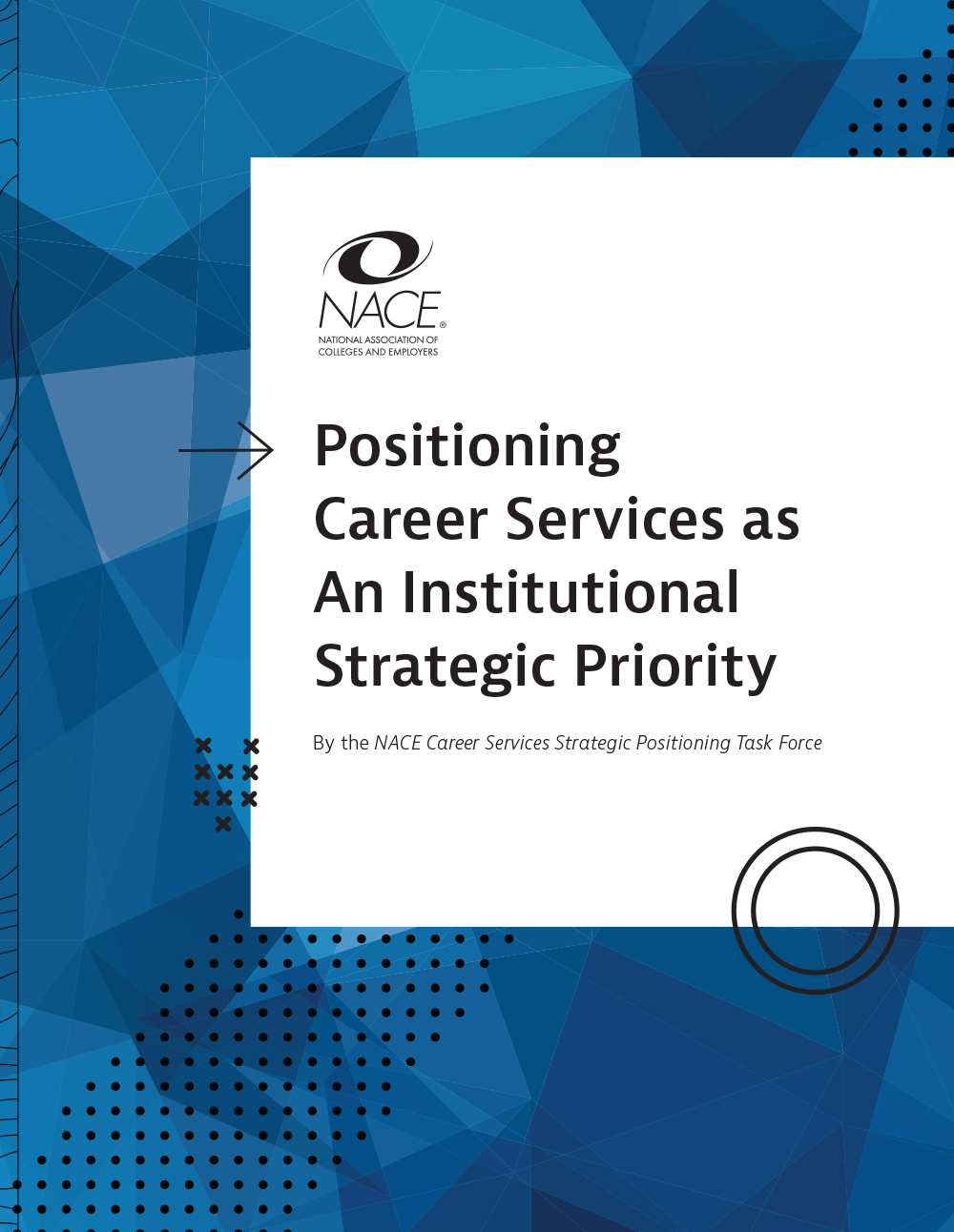Soon after Mark Peltz was hired as the associate dean and director of career development at Grinnell College in 2011, the college began a process of institutional elevation and prioritization of career services.
Specifically, President Raynard Kington decided that he wanted Peltz to report directly to him. The president noted that he wanted to reconsider how the college was supporting student career development in light of the rising cost of attendance and turbulent job market, as well as growing interest about (and feedback on) career development from students, alumni, faculty, and members of the Board of Trustees (BOT).

Positioning Career Services as an Institutional Priority
Featuring case studies and a roadmap for elevating career services on campus.DOWNLOAD NOW
According to Peltz, this was a “best-case scenario” since this gave assurance the president wanted this and believed in the importance of career services work and, if done well, would serve to strengthen Grinnell’s value proposition to both current and prospective students.
Flash forward to present day: Peltz, the Daniel and Patricia Jipp Finkelman Dean of Careers, Life, and Service (CLS), reports directly to the president of the institution; is a member of the college’s senior staff; and, as a result, is directly involved and regularly engaged with the college’s BOT.
He notes that having the support of the president is an essential element to the success of this alignment.
“I have been blessed to work for and with two great presidents during my time at Grinnell,” Peltz says.
“Both have been ardent supporters of our work and have been thoughtful and helpful partners in ensuring career development remains an integral part of the student experience at Grinnell.”
Additionally, he continues, serving on the president’s senior leadership team allows Peltz and his team to quickly identify and engage in collaborative initiatives with other divisions of the college—such as enrollment, student affairs, or development and alumni relations—and to adapt efforts and strategies around emerging institutional priorities.
“Reporting directly to the president eliminates the prospect of getting buried or lost in a division with multiple departments and priorities,” Peltz explains.
“We routinely work cross-divisionally at Grinnell, collaborating with academic departments, the dean’s office, admission, development, student affairs, and many others. This is not to say this kind of work isn’t possible at institutions where career education might be situated within a division. My experience has simply been that these kinds of collaborations are easier and move more quickly at Grinnell.”
When Peltz started at Grinnell in 2011, the career staff was composed of six FTE, and one of the positions was vacant, leaving just one staff member to advise students. As of summer 2022, he oversees a team of 22, and the department offers students a student-to-adviser ratio of 1:150.
The Change Process: From “Fixer Upper” to Dream Home
The way in which Peltz describes the change process was that he was asked to repair a “fixer upper,” i.e., there were good bones and a strong history, but a lot of work to do, while simultaneously designing a dream home.
He knew he needed to tackle some short-term, immediate needs while rethinking the office’s present work and imagining the future. This is a challenging task at any time, but particularly so when there are plenty of day-to-day challenges that demand attention.
In addition to the reporting change, President Kington also asked Peltz to co-chair the college’s strategic planning subcommittee on postgraduate success alongside a faculty member. Following this process, it was decided to merge the career development office with two other programmatic areas: 1) civic engagement and 2) post-graduate service and fellowship advising. A desire to provide a more seamless and integrated experience for students motivated these structural shifts.
To make the most of this opportunity, Peltz and his team enlisted the support of two consultants to help them go back to the drawing board and reimagine what an integrated and more holistic model of career development might look like in this liberal arts context. The team gathered data and held ideation sessions involving students, faculty, and alumni. Ultimately, this resulted in the name change—to the Center for Careers, Life, and Service (CLS)—and a strategic plan and campaign to build awareness at Grinnell about the new name, mission, vision, and impact for the center.
“Since I was still relatively new in my role, I felt strongly that I wanted to be part of the process with my team,” Peltz says.
“It’s challenging, I find, to both facilitate and be part of a visioning process. Engaging two skilled facilitators proved invaluable and most assuredly led to a better plan to guide our future.”
Funding
In 2013, a gift of approximately $1.5 million from the then chair of the Board and her spouse—with whom Peltz has a close relationship and whom he describes as “true believers in our work” and “tirelessly supportive”—was a game changer. The gift was designated as the “Finkleman Deanship Fund” and offered the named dean complete discretion in how the funds could be used to support career-related initiatives.
The donors were also explicit that they wanted their gift to be additive and not used as budget relief. Their gift—along with some other major gifts around the same the time—marked the beginning of what has led to more than $13 million in gifts to support CLS initiatives, including major gifts to launch four the CLS’s seven career communities. The other three were created through budget allocations and institutional investments.
“It’s difficult to put into words what it means to have others so thoroughly believe in the work you’re doing,” Peltz says.
“Dan and Patricia Finkelman are certainly two of those individuals and were engaged very early on in our process of reimagining what career education could look like in a highly selective, liberal arts context.”
He says others have made multiple gifts to support the work of the CLS (click here and here for examples). These donations have enabled Peltz and his team to:
- Invest in new technologies and capital improvements to its space;
- Strengthen its industry advising through multiple career communities;
- Expand access to internships;
- Launch new grant-funding initiatives; and
- Experiment, generally, with innovative ideas to better prepare Grinnell students for their post-college lives.
“When others believe in and invest in your work, it drives you to do your best,” Peltz says.
“It’s the perfect blend of challenge and encouragement.”
The CLS Today
While the entire department consists of 22 team members, 15 are in relatively traditional career development roles. The nine additional roles—growing from six—came through a combination of fundraising, budget restructuring, and strategic investments made by the college. Because of the considerable staffing resources, every incoming first-year and transfer student is now assigned an adviser from the Exploratory Career Community. As their professional aspirations clarify, the student transitions into one or more of the CLS’s pre-professional career communities, e.g., Arts, Media & Communication; Education Professions; Business & Finance; Health Professions.
By creating a shared vision, generating stakeholder trust and buy-in, and securing considerable support—financial and institutional—Grinnell College has completely transformed its approach to supporting the career development and post-graduate success of its students.
Advantages and Challenges
There were many advantages to reporting directly to the president. These included having a clear and immediate sense of institutional priorities, and, because the president appointed Peltz to the institution’s Budget Planning Committee, having a more-nuanced understanding of how institutional finances work. In addition, Peltz’s position as a direct report to the president gave him ready access to other institutional leaders in other divisions, which helped his understanding of the college’s immediate and pressing challenges and collaboration opportunities, thus boosting his institutional savvy. Finally, as Peltz noted, “it does not hurt that the president knows what you are doing.”
On the flip side, reporting to the president can come with challenges. The nature of the president role means the incumbent is incredibly busy with significant demands. Consequently, it requires one to be “really efficient and really well-prepped for meetings and one-on-ones since there is not a lot of time for side chatter… you have to be pretty well-focused because you may only have 30 minutes with that individual every two or three weeks,” Peltz noted.
Another challenge: Such a change may not be permanent as reporting lines can shift with a new president. Fortunately for Grinnell, this has not been the case. Prior to becoming Grinnell’s current president, Anne Harris was the vice president for academic affairs and dean of the college at Grinnell; Peltz already had a positive working relationship with her, and Harris possessed a degree of familiarity with Peltz’s work.
He says that a key lesson he has learned throughout this process is that aligning one’s work with institutional priorities is essential.
“While one may think it’s patently obvious how your work advances your institution’s mission, it’s a mistake to make such an assumption,” Peltz explains.
“When career center leaders are presented with an opportunity to contribute—to define institutional goals, to share the good work their team is doing, to help address a problem—they should be ready.”
He suggests his colleagues in career centers who may be part of a similar alignment shift maintain an open mind to what might be possible.
“They should be willing to be wrong, and reconsider their perspectives,” Peltz advises.
“They should create opportunities for their stakeholders to contribute and provide input. They should listen, hone their ability to tell the story of their center, and never underestimate the value of both quantitative and qualitative measures. Both matter.”







